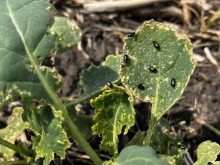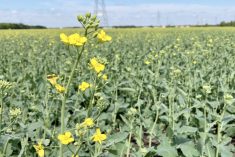Prairie winter wheat growers whose No. 2 Canada Western red winter (CWRW) crop has turned up with high levels of fusarium have until Oct. 31 to get in on a Canadian Wheat Board program to deliver it.
The CWB last week rolled out a Series A 2010-11 delivery program in which CWRW growers can deliver crops testing higher than the normal tolerance levels for fusarium, “while maintaining export standards and ensuring customers receive a safe product.”
Under the contract, for which sign-up began Friday (Oct. 8) and runs until the end of this month, No. 2 CWRW will be accepted with no higher than three per cent fusarium content, the CWB said.
Read Also

Entomologist tests trap crops and marigolds to repel flea beetles at an Ag in Motion
An Agriculture Canada entomologist is experimenting with trap crops and marigolds at an Ag in Motion demonstration cropplot
Initial payments, however, will be subject to a tonnage discount, based on the difference between the fusarium level in a farmer’s delivery and the Canadian Grain Commission’s maximum fusarium tolerance of two per cent.
The discount will be multiplied this year by a weighting factor of five to reflect the initial payment price spread difference between Nos. 1 and 2 CWRW, the CWB said.
Fusarium head blight, which builds up harmful mycotoxins and drives down quality in infected cereal crops, was able to thrive this summer in winter wheat during hot, humid conditions and abnormally wet weather.
Anita Brule-Babel, a University of Manitoba wheat breeder, noted in mid-August that the incidence of fusarium head blight has been seen as “particularly high” in winter wheat in 2010.
“We have seen a lot of fusarium head blight infection in the winter wheat crop in most of the southern Prairies and that is just because we have had these very hot humid conditions at the time of flowering,” she said Aug. 18 on the hog industry-sponsored program Farmscape.
“From that perspective, if in areas where we have some fairly high levels of infection, marketability of that grain for either feed or food is going to be somewhat limited.”



















